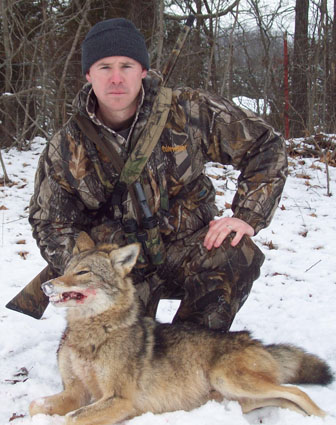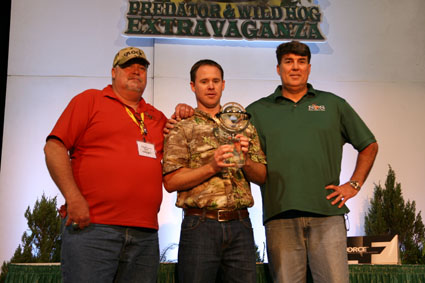 When did you start calling predators?
When did you start calling predators?
I’ve been hunting as long as I can remember. I grew up deer, duck, and small game hunting. I didn’t take up predator hunting until about 15 years ago. I am a student of coyote hunting, always willing to learn from and listen to others.
Do you hunt differently once winter sets in?
Yes and No. Eleven months out of the year the coyote is concerned about putting food in his stomach. During the winter the availability of food is at its all-time low for the year, so coyotes are always looking to fill their bellies. Coyotes will respond to prey sounds all year long, and I will use them on every stand, regardless of the time of year. However, as the winter months approach and the mating season nears, I will add more canine sounds to the end of my call stand; for example female invites/invitation and challenge howls. Here in Tennessee the mating season occurs mainly during the month of January. As this time approaches, the coyotes become very territorial, trying to find a mate and establish their own territory or home turf. Challenge howls and even lone howls at the end of a stand will often create a coyote’s response. And of course the invite howl of a young female has been the death of many males during the winter months when coyotes are looking for love.
What type sound/call do you usually open your stand with?
Yeah, I know everybody is expecting me to say I begin my winter stand with a lone howl like you see on TV. I am sorry, but I very rarely do that. I still, regardless of the time of year, will start with something low volume, such as rodent squeaks or an occasional house cat. I can’t tell you the number of dogs we have had respond just seconds into our calling sequence. Obviously these dogs were close when we first started calling. I don’t want to alarm or scare these “close quarters” coyotes. As time on the stand progresses, I will increase my volume and that might include a lone howl, canine distress, or female invite.
If a coyote doesn’t respond right away, do you change your calling up and if so, to what?
It really depends. I always use multiple sounds, starting quiet and then as the time on stand prolongs, I will increase the volume. For example, first rodent squeaks and then move into a mid-range volume cottontail, and then maybe a ki-yi/dog distress. But, before I ever begin my hunt, I have a game plan. I have the stands I will make and the order I will make them in already planned out in my head. So when calling on a stand, I am always considering where my next stand will be and what territory my sounds will be influencing. I ask myself, “On my next stand, will that move put me closer to coyotes?” If so, I will not get very aggressive/loud on the current stand. Save your “thunder.”
How long will you stay on stand?
 Approximately 20 minutes (I may have a slight case of ADD, though). I like to keep things moving, run and gun, cover as much territory as I possibly can. Here in the Southeast, we are calling small fields, rolling hills, thickets, gullies, ditches, cut-overs, and dense hardwoods; your sound does not travel as far as it might in other parts of the country. So, if a coyote is near and he is hungry, he will show up relatively quick. There are always exceptions to the rules, I always consider the terrain, so if I’m hunting an area where it might take a coyote a little longer to show himself, I will wait a little longer. When using canine sounds I recommend staying on stand a few extra minutes, as they usually don’t come charging in like they do when using prey sounds. Often they may just come to the edge and stand there looking—“shoot him!”
Approximately 20 minutes (I may have a slight case of ADD, though). I like to keep things moving, run and gun, cover as much territory as I possibly can. Here in the Southeast, we are calling small fields, rolling hills, thickets, gullies, ditches, cut-overs, and dense hardwoods; your sound does not travel as far as it might in other parts of the country. So, if a coyote is near and he is hungry, he will show up relatively quick. There are always exceptions to the rules, I always consider the terrain, so if I’m hunting an area where it might take a coyote a little longer to show himself, I will wait a little longer. When using canine sounds I recommend staying on stand a few extra minutes, as they usually don’t come charging in like they do when using prey sounds. Often they may just come to the edge and stand there looking—“shoot him!”
Do you scout prior to calling in an area and if so how do you like to scout?
I’ll start by telling myself, “Coyotes are everywhere.” So, in my opinion, it is possible to call coyotes on any given piece of property. But you are at an advantage if you “know” the land. Unlike the West, most of the places we are hunting here in the Southeast are small 30-300 acre tracts. So, if coyotes are not on your property they are on the neighbor’s. Scouting specifically for a coyote is not something I do very often. I turkey and deer hunt as well, so I am constantly in the field. When I notice coyote sign, I make a mental note. My scouting consists mainly of determining the best spots to call from. I often do this from the truck or even aerial maps. Many times you only have one or two stands on a farm, so you want to make it from the best possible stand location. These “best stand locations” are found by doing your homework.
What is your favorite brand of call to use?
I am not an e-caller kind of guy. They work, no doubt. There is just something about calling in coyotes with a manual/mouth call that I love. My favorite call would have to be the call that my hunting partner and I designed and make: The Deceiver (to order or learn more about this call, email contact@harvestoutdoorministries.com). These are closed-reed style calls; we make both a single and double-reed model. I used these calls to win the two World Predator Calling titles. Is this all I use? No. I use ’em all. All companies make good sounding calls, and they all call in coyotes. I use open reed, closed reed, and even mouth diaphragm calls. They all have their place and time. Find one YOU like, practice and call coyotes.
What has made you so successful in predator calling competitions?
I can’t answer this question without giving credit to where credit is due—my Lord Jesus Christ. It is all for His glory. I thank Him for the opportunity to compete and for God-given talent to produce sounds that judges like. To answer your question: practice, realism and creativity. Lots of practice. I really enjoy stage-calling competitions. It’s a lot of fun, good for the sport, and it will make you a better caller. Although I have been successful over the years in stage calling contest, one contest win that I am most proud of is a couple of years ago my team won the West Tennessee Coyote Calling Championship. There were 69 teams in the contest. We took first place in the contest by adapting our calling strategies in warm temps and high winds.
Is there anything else that you would like to add?
Yeah, don’t give up. Keep after ’em. It’s easy to get discouraged when hunting coyotes. But who knows, your next stand may be the one! One more thing, give a motion decoy a try and get ready for some close encounters! God Bless and shoot straight!






